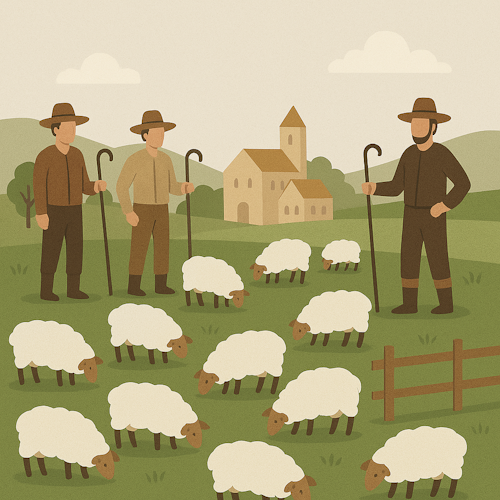The Tragedy of The Commons
Illustrates Collective Ownership, Codebase Care, Team Responsibility
In Agile teams and organizations, shared resources are everywhere. Shared ownership of code. Shared understanding of goals. Shared responsibility for delivery. But shared does not mean free. And without boundaries, care, and communication, shared systems can break down. The Tragedy of the Commons is a parable that helps teams understand why good intentions are not enough when working in a collective system.

Once in a quiet village, there was a wide open pasture in the center of town. The Commons. All families were allowed to graze their sheep there. It was free to use, and for many years, it worked just fine.
Each family had just a few sheep. They took care not to overgraze. They knew their neighbors depended on the same grass. But as the town grew, so did the herds.
One family added a few more sheep. “Just a few more,” they said. “Everyone else is doing fine. It won't hurt.”
Another family saw this and thought, “If they are adding sheep, we should too. Otherwise, we lose out.”
Soon, everyone was adding sheep. The grass thinned. The soil eroded. The Commons turned to dust.
Families blamed each other. But no one had done anything extreme. Just a little extra. Just one more sheep.
In the end, the pasture was gone. And with it, the shared benefit they had all once enjoyed.
Lessons Learned
Shared Resources Need Shared Stewardship
The pasture did not belong to one person. It belonged to all. But when everyone assumed someone else would take care of it, no one did. Agile teams face this with shared codebases, environments, or working agreements. Without intentional care, decay sets in.
Local Optimization Leads to Global Failure
Each family acted in its own interest, thinking small actions would not matter. But combined, those choices ruined the system. In Agile organizations, team-level optimizations that ignore system health can undermine flow, alignment, and trust.
Sustainability Requires Limits
The pasture could have lasted generations with agreed limits and guardrails. Teams need working agreements, quality standards, and WIP limits to avoid overloading systems. These constraints are not restrictions. They are investments in long-term viability.
Transparency Reduces Assumptions
If the villagers had shared grazing data or met regularly to discuss usage, they might have seen the danger earlier. Agile teams benefit from metrics, visibility, and cadence-based reflection to spot patterns before damage occurs.
Coordination Is Not Optional
Acting independently in a shared system invites collapse. Coordination does not mean consensus on everything. It means structured collaboration to protect the whole. Scrum events, flow reviews, and cross-team syncs are examples of this.
Coaching Tips
- Use this Parable when Tech Debt Feels Invisible: Help teams see that unchecked "just one more thing" choices accumulate and create harm over time.
- Explore Shared Ownership: Ask teams what they all rely on, but no one owns. This could be documentation, test automation, or deployment pipelines.
- Introduce the Concept of Social Contracts: Like villagers setting limits, teams can define boundaries and agreements that ensure health over time.
- Connect to Flow Efficiency: If one team moves fast at the expense of another, the whole system suffers. Use the parable to illustrate why looking at the big picture matters.
Agile does not thrive in silos. It thrives in ecosystems. The Tragedy of the Commons reminds us that shared systems fail when everyone optimizes for themselves. True agility comes not from speed, but from care, awareness, and collective stewardship.
When everyone owns the outcome, everyone must also protect the path.


